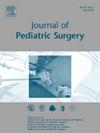儿童欧米茄-空肠造口术后肠蠕动障碍和肠扭转的风险。
IF 2.5
2区 医学
Q1 PEDIATRICS
引用次数: 0
摘要
胃动力障碍使儿童肠内喂养复杂化,通常需要远端喂养通道。虽然鼻十二指肠和胃空肠造口管是常见的,但频繁的移位需要去医院进行透视引导下的更换,使儿童暴露于辐射和潜在的麻醉风险。omega-空肠造口术(OJ)管是一种比roux-en-Y喂养空肠造口术更简单的替代方法,可以在肠道成熟后方便地在家中更换管。尽管使用了近20年,oj管的放置仍然很不明确。本研究考察了儿童在单一中心放置oj管后的患者因素和结果。方法:回顾性分析2016-2024年在某学术儿童医院行oj管置入术的23例患儿。我们分析了人口统计学、围手术期和结果数据,包括肠扭转发生率、再手术、急诊科(ED)就诊和再入院。结果:发生肠扭转17.4% (n=4),需要紧急开腹手术。扭转患者住院时间较长(12.0对3.5天,p=0.02), 30天再入院率较高(100%对15.8%,p=0.004)。75%的肠扭转病例存在肠道运动障碍,提示易患肠扭转(p=0.07)。73.9%的患者出现急诊科就诊,主要原因是导管堵塞(35.3%)或移位(29.4%)。讨论:oj管放置是一种有效的喂养选择,但存在风险,包括肠扭转和频繁的急诊科就诊。肠道运动障碍可能使患者易发生肠扭转,因此需要仔细选择和监测患者。改善护理人员教育和机械并发症管理可减少ED的使用。需要进一步的多中心研究来评估这一人群的扭转风险。研究类型:回顾性队列研究证据等级:III。本文章由计算机程序翻译,如有差异,请以英文原文为准。
Intestinal Dysmotility and the Risk of Volvulus Following Omega-jejunostomy Tube Placement in Children
Introduction
Gastric dysmotility complicates enteral feeding in children, often requiring distal feeding access. While nasoduodenal and gastrojejunostomy tubes are common, frequent dislodgements necessitate hospital visits for fluoroscopic-guided replacement, exposing children to radiation and potential anesthesia risks. The omega-jejunostomy (OJ) tube was developed as a simpler alternative to roux-en-Y feeding jejunostomy, allowing easy at-home tube changes after tract maturation. Despite nearly two decades of use, OJ-tube placement remains poorly characterized. This study examines patient factors and outcomes following OJ-tube placement in children at a single center.
Methods
A retrospective review was conducted on 23 pediatric patients who underwent OJ-tube placement at an academic children's hospital (2016–2024). We analyzed demographic, perioperative, and outcome data, including volvulus incidence, reoperations, emergency department (ED) visits, and readmissions.
Results
Intestinal volvulus occurred in 17.4 % (n = 4), requiring emergent laparotomy. Patients with volvulus had longer hospital stays (12.0 vs. 3.5 days, p = 0.02) and higher 30-day readmission rates (100 % vs. 15.8 %, p = 0.004). Intestinal dysmotility was present in 75 % of volvulus cases, suggesting a predisposition (p = 0.07). ED visits occurred in 73.9 % of patients, primarily due to clogged (35.3 %) or dislodged tubes (29.4 %).
Discussion
OJ-tube placement is an effective feeding option but carries risks, including volvulus and frequent ED visits. Intestinal dysmotility may predispose patients to volvulus, warranting careful patient selection and monitoring. Improved caregiver education and mechanical complication management may reduce ED utilization. Further multicenter research is needed to assess volvulus risk in this population.
Type of study
Retrospective Cohort Study.
Level of evidence
III.
求助全文
通过发布文献求助,成功后即可免费获取论文全文。
去求助
来源期刊
CiteScore
1.10
自引率
12.50%
发文量
569
审稿时长
38 days
期刊介绍:
The journal presents original contributions as well as a complete international abstracts section and other special departments to provide the most current source of information and references in pediatric surgery. The journal is based on the need to improve the surgical care of infants and children, not only through advances in physiology, pathology and surgical techniques, but also by attention to the unique emotional and physical needs of the young patient.

 求助内容:
求助内容: 应助结果提醒方式:
应助结果提醒方式:


